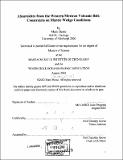| dc.contributor.advisor | Timothy Grove. | en_US |
| dc.contributor.author | Hesse, Marc, 1976- | en_US |
| dc.contributor.other | Woods Hole Oceanographic Institution. | en_US |
| dc.coverage.spatial | n-mx--- | en_US |
| dc.date.accessioned | 2010-04-28T15:33:45Z | |
| dc.date.available | 2010-04-28T15:33:45Z | |
| dc.date.copyright | 2002 | en_US |
| dc.date.issued | 2002 | en_US |
| dc.identifier.uri | http://hdl.handle.net/1721.1/54446 | |
| dc.description | Thesis (S.M.)--Joint Program in Oceanography (Massachusetts Institute of Technology, Dept. of Earth, Atmospheric, and Planetary Sciences and the Woods Hole Oceanographic Institution), 2002. | en_US |
| dc.description | Includes bibliographical references (p. 22-28). | en_US |
| dc.description.abstract | We have investigated the near liquidus phase relations of a primitive absarokite from the Mascota region in Western Mexico. Sample M. 102 was chosen because it has high MgO contents, a high Mg# and Fo90 olivine phenocrysts, indicating it is primitive mantle melt. Highpressure experiments on a synthetic analogue of the absarokite composition with a H20 content of either -1.7 wt% or -5.1 wt% were carried out in a piston cylinder apparatus. The composition with -1.7 wt% H20 is multiply saturated with olivine and orthopyroxene as liquidus phases at 1.6 GPa and 14000C. At the same pressure clinopyroxene appears 300C below the liquidus. With a H20 content of -5.1 wt% composition M.102 is multiply saturated with olivine and orthopyroxene on the liquidus at 1.7 GPa and 13000 C. Assuming batch melting, we suggest that absarokite M. 102 segregated from a depleted lherzolite or harzburgite residue at depth -50 km depth in the mantle wedge. Unlike most lavas in the region, the absarokite has not ponded and fractionated at the crust mantle interface (-35-40 km), and the temperatures of multiple saturation indicate that the mantle wedge beneath the Jalisco block is hotter than previously thought. The low degree batch melting of an original metasomatised harzburgite source, can produce the observed trace element abundances. The liquidus phase relations are not consistent with the presence of non-peridotitic veins at the depth of last equilibration. Therefore, we propose that the Mascota absarokites segregated at an apparent melt fraction of less than 5% from a depleted peridotitic source. They initially formed by a small degree of melting of a metasomatised original source at greater depth. | en_US |
| dc.description.statementofresponsibility | by Marc Hesse. | en_US |
| dc.format.extent | 45 p. | en_US |
| dc.language.iso | eng | en_US |
| dc.publisher | Massachusetts Institute of Technology | en_US |
| dc.rights | M.I.T. theses are protected by
copyright. They may be viewed from this source for any purpose, but
reproduction or distribution in any format is prohibited without written
permission. See provided URL for inquiries about permission. | en_US |
| dc.rights.uri | http://dspace.mit.edu/handle/1721.1/7582 | en_US |
| dc.subject | Earth, Atmospheric, and Planetary Sciences. | en_US |
| dc.subject | Joint Program in Oceanography. | en_US |
| dc.subject | Woods Hole Oceanographic Institution. | en_US |
| dc.subject.lcsh | Submarine geology. | en_US |
| dc.title | Absarokites from the Western Mexican Volcanic Belt : constraints on mantle wedge conditions | en_US |
| dc.type | Thesis | en_US |
| dc.description.degree | S.M. | en_US |
| dc.contributor.department | Joint Program in Oceanography | en_US |
| dc.contributor.department | Woods Hole Oceanographic Institution | en_US |
| dc.contributor.department | Massachusetts Institute of Technology. Department of Earth, Atmospheric, and Planetary Sciences | |
| dc.identifier.oclc | 52044493 | en_US |
